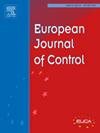Nonlinear cruise controllers with bidirectional sensing for a string of vehicles
IF 2.6
3区 计算机科学
Q2 AUTOMATION & CONTROL SYSTEMS
引用次数: 0
Abstract
We introduce a nonlinear cruise controller that is fully decentralized (by vehicle) and uses spacing and speed measurements from the preceding and following vehicles to decide on the appropriate control action (acceleration) for each vehicle. The proposed cruise controller is studied on both a ring-road and an open road and guarantees that there are no collisions between vehicles, while their speeds are always positive and never exceed the road speed limits. For both cases of the open road and the ring-road, we rigorously prove that the set of equilibrium points is globally asymptotically stable and provide estimates that guarantee uniform convergence to the said set. Moreover, we show that for the ring-road, and under certain conditions, there is a single equilibrium point which is exponentially attractive. Finally, for the case of an open road we provide (small-signal) string stability estimates and demonstrate numerically that also string stability holds.
一串车辆的双向传感非线性巡航控制器
我们引入了一个非线性巡航控制器,它是完全分散的(按车辆),并使用前车和后车的间距和速度测量来决定每辆车的适当控制动作(加速度)。所提出的巡航控制器在环形道路和开放道路上进行了研究,并保证车辆之间不发生碰撞,同时车辆的速度始终为正且不超过道路速度限制。对于开放道路和环形道路这两种情况,我们严格证明了平衡点集合是全局渐近稳定的,并给出了保证该集合一致收敛的KL估计。此外,我们还证明了对于环形公路,在一定条件下,存在一个指数吸引的单一平衡点。最后,对于开放道路的情况,我们提供了(小信号)L2弦稳定性估计,并通过数值证明L∞弦稳定性也成立。
本文章由计算机程序翻译,如有差异,请以英文原文为准。
求助全文
约1分钟内获得全文
求助全文
来源期刊

European Journal of Control
工程技术-自动化与控制系统
CiteScore
5.80
自引率
5.90%
发文量
131
审稿时长
1 months
期刊介绍:
The European Control Association (EUCA) has among its objectives to promote the development of the discipline. Apart from the European Control Conferences, the European Journal of Control is the Association''s main channel for the dissemination of important contributions in the field.
The aim of the Journal is to publish high quality papers on the theory and practice of control and systems engineering.
The scope of the Journal will be wide and cover all aspects of the discipline including methodologies, techniques and applications.
Research in control and systems engineering is necessary to develop new concepts and tools which enhance our understanding and improve our ability to design and implement high performance control systems. Submitted papers should stress the practical motivations and relevance of their results.
The design and implementation of a successful control system requires the use of a range of techniques:
Modelling
Robustness Analysis
Identification
Optimization
Control Law Design
Numerical analysis
Fault Detection, and so on.
 求助内容:
求助内容: 应助结果提醒方式:
应助结果提醒方式:


